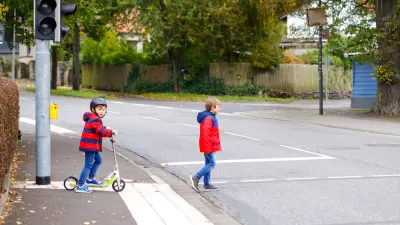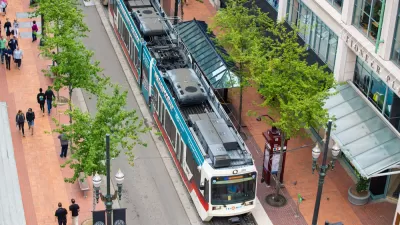The majority of pedestrian master plans consider how to make equitable walking infrastructure. Less than half of plans implement strategies to address the fact that people of color are disproportionately represented in pedestrian fatalities.

Amber Berg and Gregory Newmark's new paper "Incorporating Equity into Pedestrian Master Plans" analyzes 15 pedestrian master plans from major American cities "to understand how some of the largest departments of transportation were — or weren’t — centering the needs of marginalized communities in their policies," writes Kea Wilson.
Wilson points to a troubling finding from Smart Growth America that older, non-white pedestrians are disproportionately more likely to be killed by drivers than white pedestrians. Wilson describes the paper's analysis:
But Berg and Newmark found that even cities with more "vertical" approaches to equity planning were not necessarily reducing disparities in their equity metrics. To understand why, they evaluated all the plans through a framework they are calling the “Three A’s”: Acknowledgment, Accountability, and Application.
Measuring equity in pedestrian plans using these three metrics, Berg and Newmark found that Portland and Seattle lead the pack. "These seemingly subtle differences, the researchers say, can have huge implications for a region’s long-term equity efforts," writes Wilson.
FULL STORY: Why Every City Needs to Learn the Three A’s of Equitable Pedestrian Planning

Maui's Vacation Rental Debate Turns Ugly
Verbal attacks, misinformation campaigns and fistfights plague a high-stakes debate to convert thousands of vacation rentals into long-term housing.

Planetizen Federal Action Tracker
A weekly monitor of how Trump’s orders and actions are impacting planners and planning in America.

San Francisco Suspends Traffic Calming Amidst Record Deaths
Citing “a challenging fiscal landscape,” the city will cease the program on the heels of 42 traffic deaths, including 24 pedestrians.

Adaptive Reuse Will Create Housing in a Suburban Texas Strip Mall
A developer is reimagining a strip mall property as a mixed-use complex with housing and retail.

Study: Anti-Homelessness Laws Don’t Work
Research shows that punitive measures that criminalized unhoused people don’t help reduce homelessness.

In U.S., Urban Gondolas Face Uphill Battle
Cities in Latin America and Europe have embraced aerial transitways — AKA gondolas — as sustainable, convenient urban transport, especially in tricky geographies. American cities have yet to catch up.
Urban Design for Planners 1: Software Tools
This six-course series explores essential urban design concepts using open source software and equips planners with the tools they need to participate fully in the urban design process.
Planning for Universal Design
Learn the tools for implementing Universal Design in planning regulations.
Heyer Gruel & Associates PA
JM Goldson LLC
Custer County Colorado
City of Camden Redevelopment Agency
City of Astoria
Transportation Research & Education Center (TREC) at Portland State University
Jefferson Parish Government
Camden Redevelopment Agency
City of Claremont





























